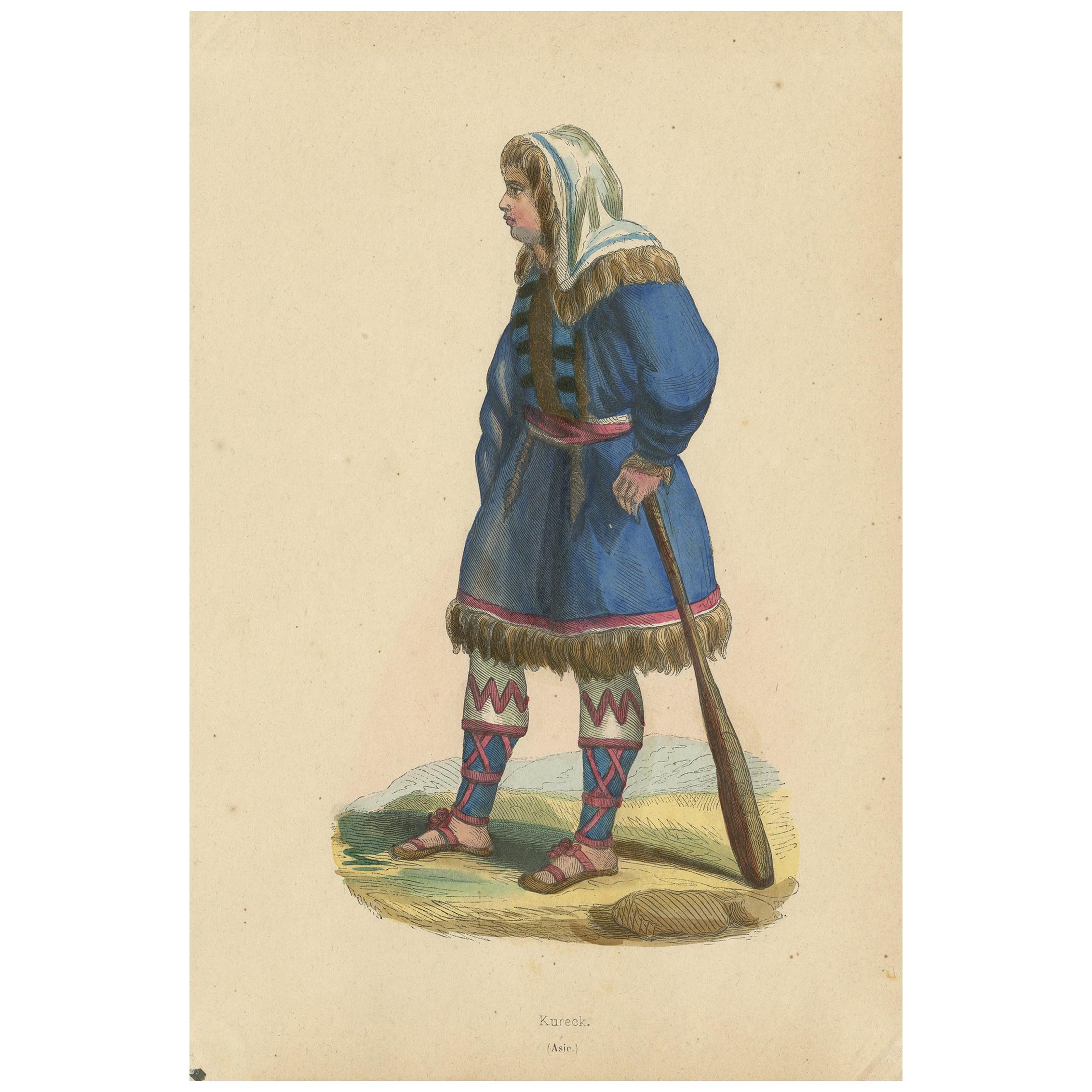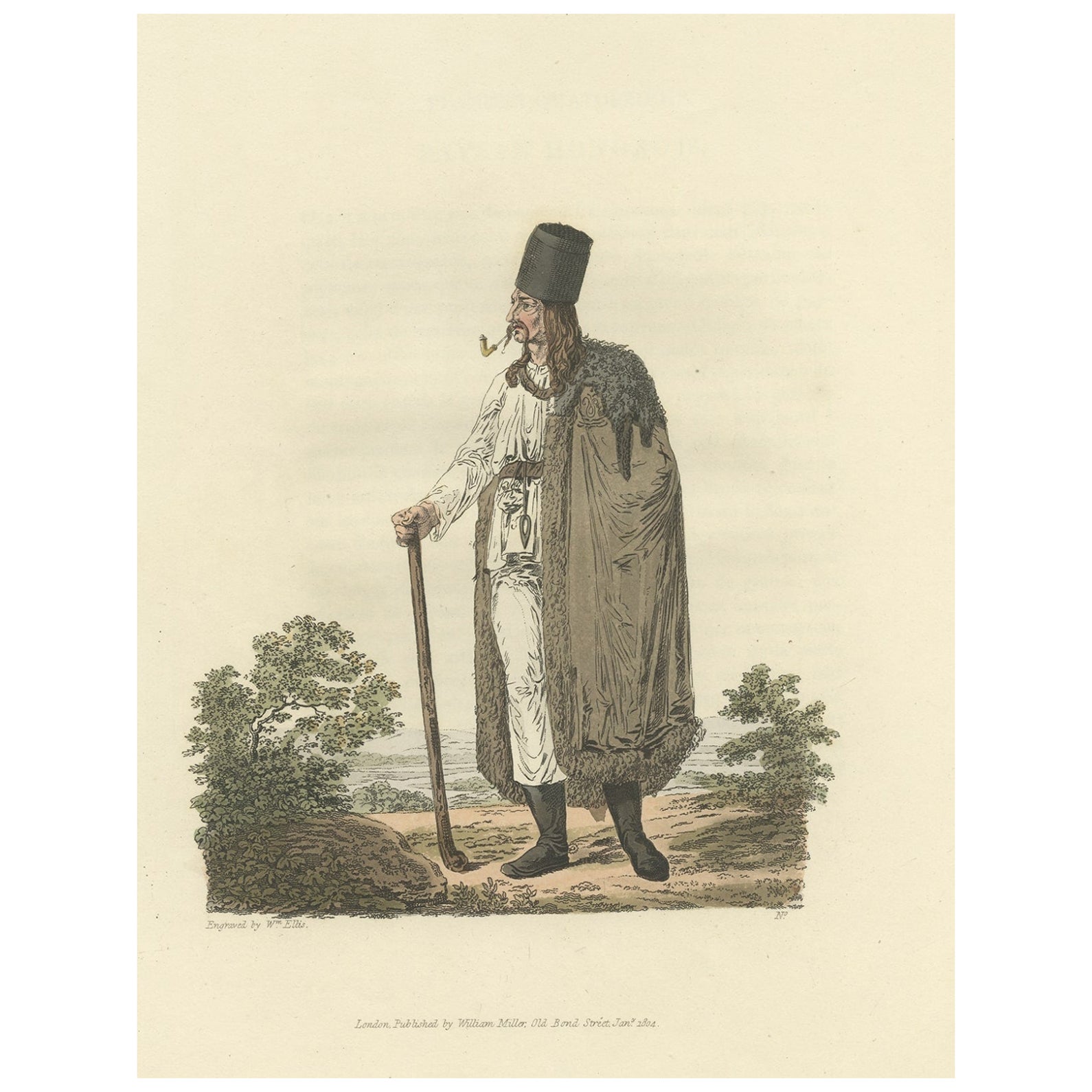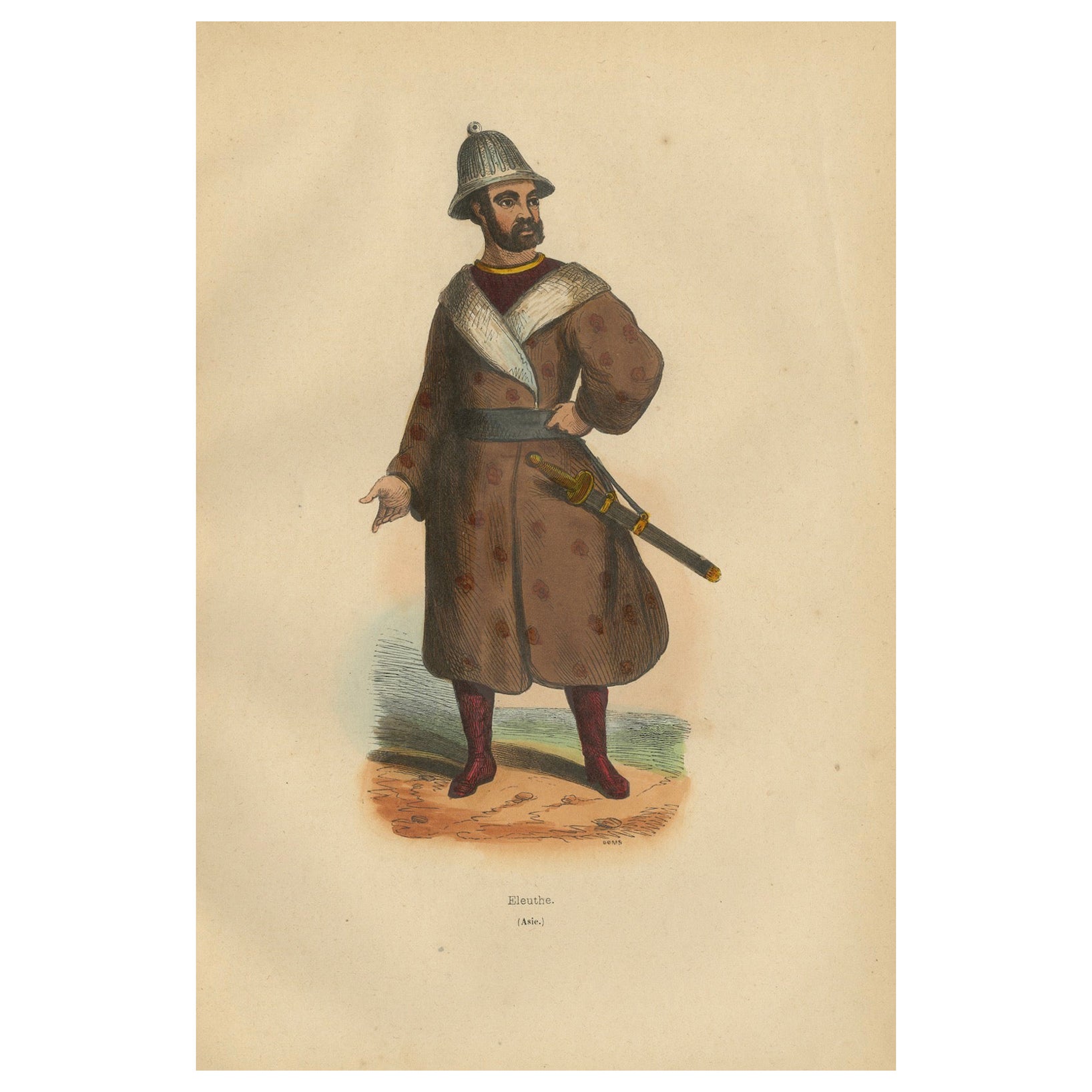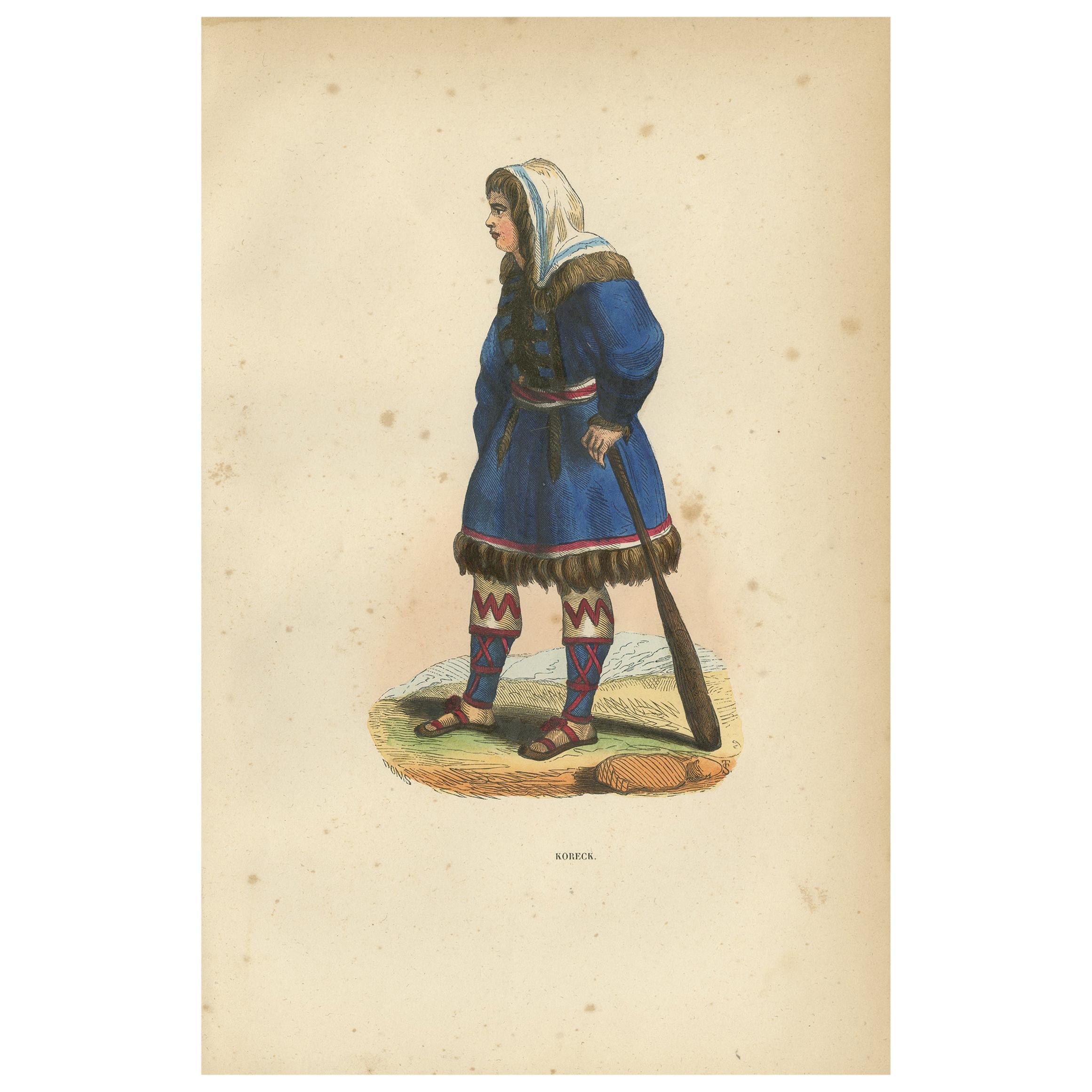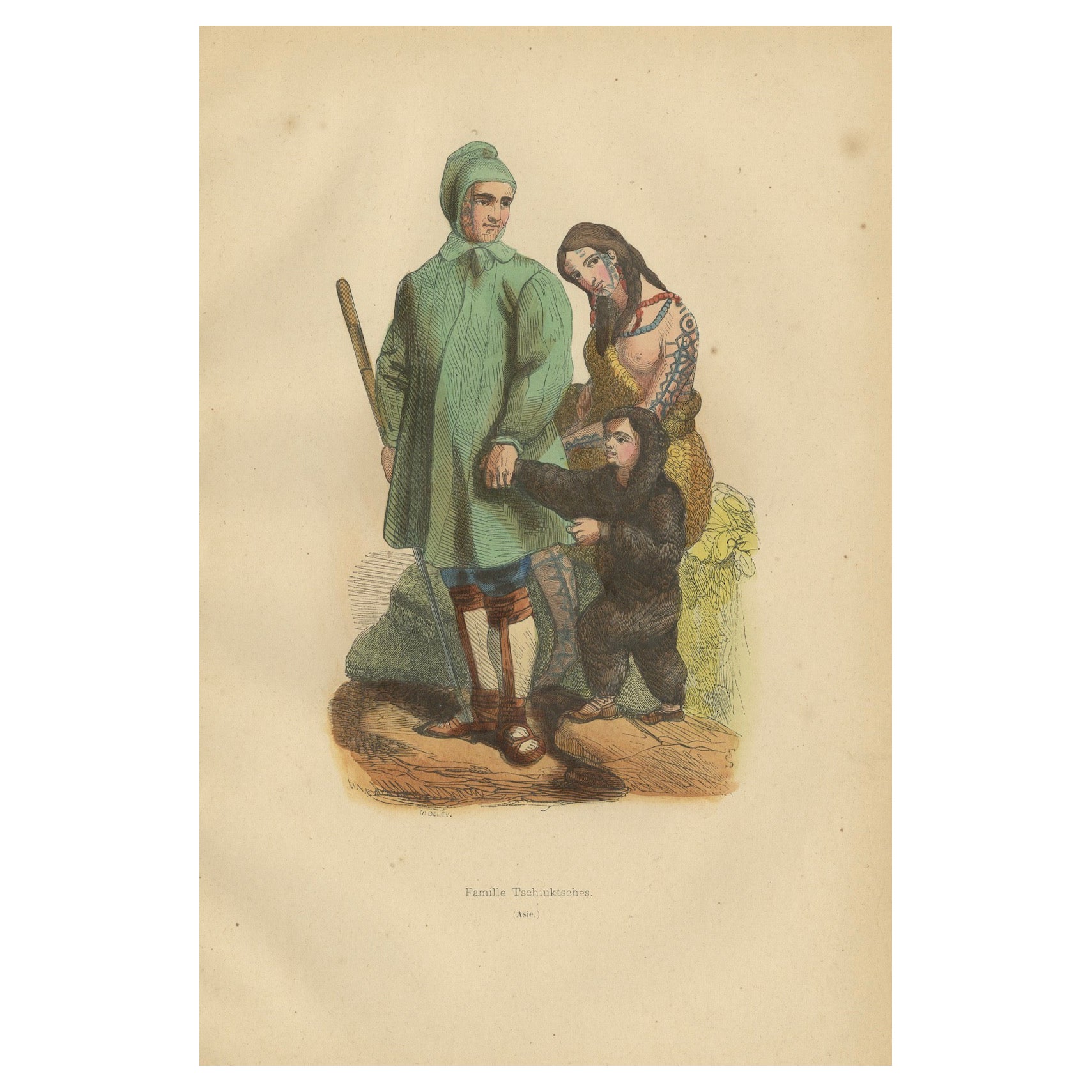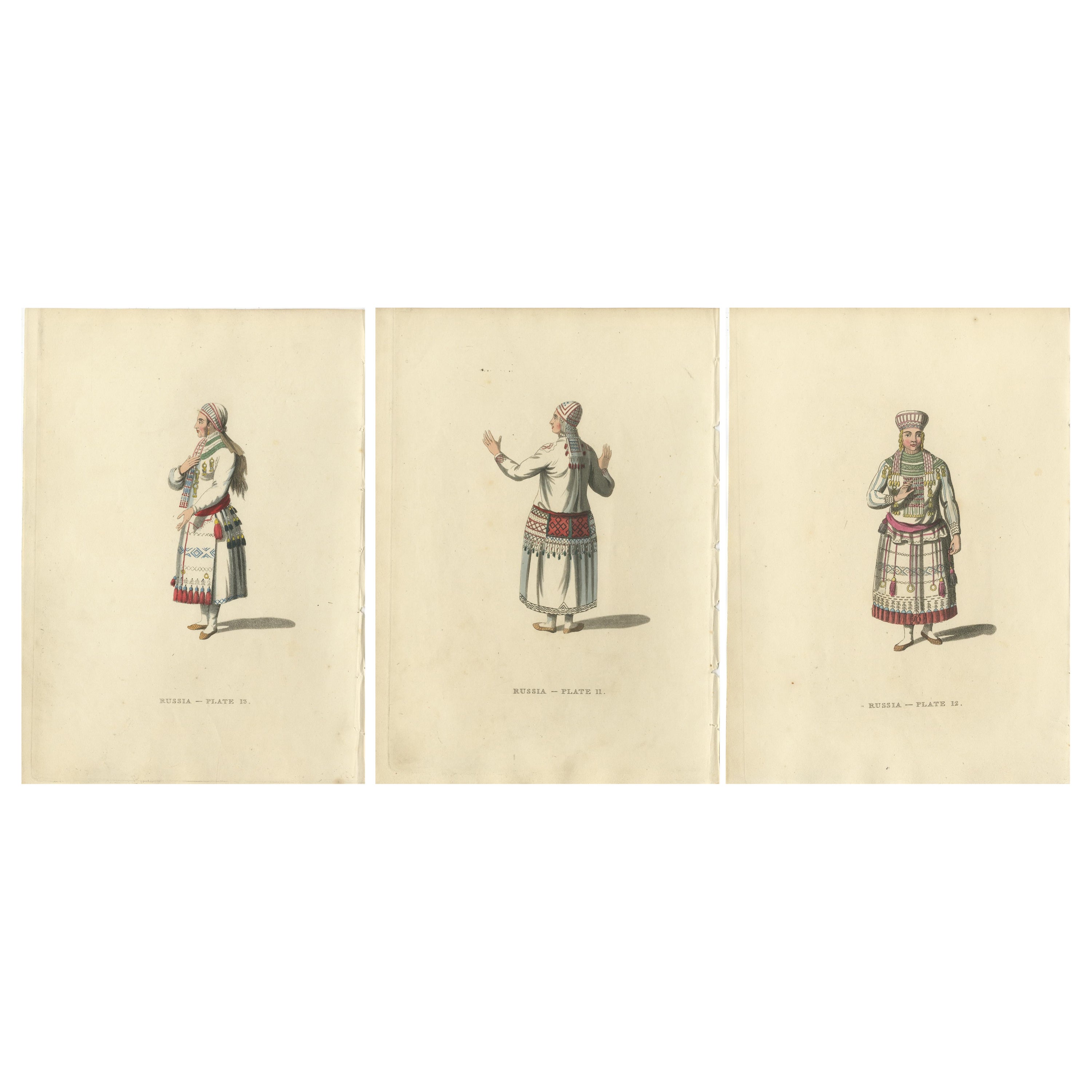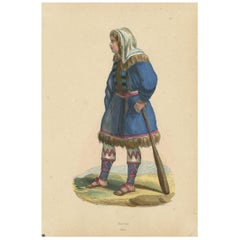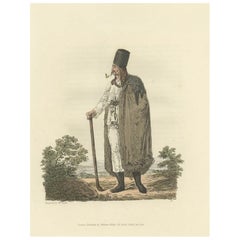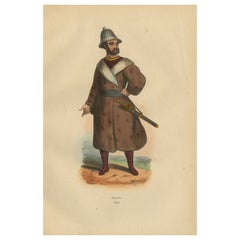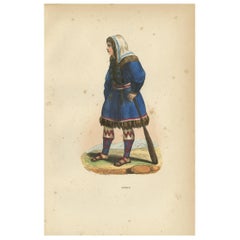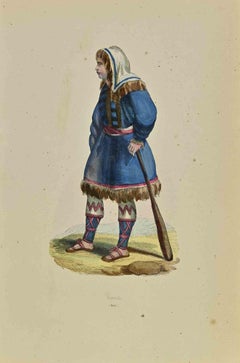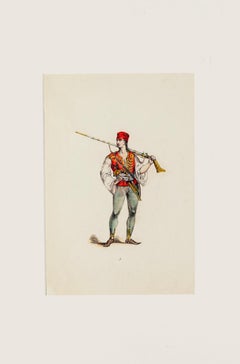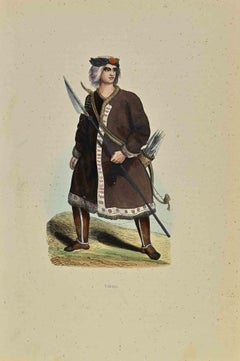Items Similar to Traditional Kurek Attire in Handcolored Lithograph from 1844
Want more images or videos?
Request additional images or videos from the seller
1 of 7
Traditional Kurek Attire in Handcolored Lithograph from 1844
$123.28
$154.0920% Off
£92.32
£115.4020% Off
€104
€13020% Off
CA$172.80
CA$21620% Off
A$190.39
A$237.9820% Off
CHF 98.56
CHF 123.1920% Off
MX$2,292.31
MX$2,865.3920% Off
NOK 1,247.96
NOK 1,559.9420% Off
SEK 1,172.38
SEK 1,465.4720% Off
DKK 792.02
DKK 990.0320% Off
About the Item
The print portrays a Kurek, likely a member of a Siberian ethnic group. This print, part of Auguste Wahlen's "Moeurs, Usages et Costumes de tous les Peuples de Monde" from 1844, highlights traditional Siberian attire, characterized by its functionality and adaptation to harsh climates.
The attire shown includes a fur-lined hooded coat, patterned leggings, and fur-trimmed boots, all designed to protect against extreme cold. The individual also carries a staff, possibly used for support in snowy or icy terrain, which emphasizes the practical aspects of daily life in such environments. The use of vibrant colors and detailed patterns on the leggings and footwear reflects the cultural significance of clothing as a form of expression beyond its utilitarian purpose.
The print depicting the Kurek offers a glimpse into the diverse and often less-known cultures of Siberia. Here are some additional interesting facts related to the attire and lifestyle of Siberian indigenous groups, like the Kurek:
1. **Adaptation to Environment:** The clothing shown in the print, notably the thick, fur-lined garments, is uniquely adapted to the Arctic and subarctic climates of Siberia. These garments are typically made from reindeer or seal skin, which provide excellent insulation.
2. **Cultural Significance of Patterns:** The patterns seen on the leggings and boots often have cultural significance, with designs passed down through generations. These patterns can represent familial ties, social status, or spiritual beliefs.
3. **Use of Natural Materials:** Apart from fur, other natural materials like leather, bones, and even fish skins are used in traditional clothing. These materials are locally sourced, showcasing the resourcefulness of indigenous peoples in using their immediate environment to meet their needs.
4. **Symbolic Staff:** The staff carried by the individual in the print could also be symbolic or have practical uses, such as for herding reindeer or as a tool for travel over uneven terrains, like icy paths or deep snow.
5. **Cultural Preservation:** The detailed documentation of such attire in prints like these serves as an important historical record, helping to preserve knowledge of the lifestyles and traditions of indigenous Siberian cultures, many of which have undergone significant changes or have been marginalized.
6. **Artistic Expression:** The rich detail and vibrant colors used in these prints not only serve an ethnographic purpose but also highlight the artistic expression inherent in everyday items of Siberian indigenous peoples, turning functional items into works of art.
These elements underscore the depth and richness of Siberian indigenous cultures, which are often characterized by their strong ties to nature and remarkable adaptability to some of the most challenging environments on earth.
This print is not only attractive for its historical and cultural insight but also for its artistic qualities, including the careful use of color and attention to detail in the depiction of the clothing and accessories, which are enhanced by the handcolored lithographic technique used.
Keywords that people might use when looking for such prints could include "Siberian ethnic costume," "traditional Siberian attire," "19th-century handcolored lithographs," "Kurek traditional dress," and "historical cultural costumes."
- Dimensions:Height: 10.12 in (25.7 cm)Width: 6.7 in (17 cm)Depth: 0 in (0.02 mm)
- Materials and Techniques:
- Period:
- Date of Manufacture:1844
- Condition:Condition: Good, given age. Faintly browned, and with some small stains. Some glue remains (from binding) in the far left margin (not affecting image). General age-related toning and/or occasional minor defects from handling. Please study the scans.
- Seller Location:Langweer, NL
- Reference Number:Seller: BG-12722-551stDibs: LU3054341384842
About the Seller
5.0
Recognized Seller
These prestigious sellers are industry leaders and represent the highest echelon for item quality and design.
Platinum Seller
Premium sellers with a 4.7+ rating and 24-hour response times
Established in 2009
1stDibs seller since 2017
2,667 sales on 1stDibs
Typical response time: <1 hour
- ShippingRetrieving quote...Shipping from: Langweer, Netherlands
- Return Policy
Authenticity Guarantee
In the unlikely event there’s an issue with an item’s authenticity, contact us within 1 year for a full refund. DetailsMoney-Back Guarantee
If your item is not as described, is damaged in transit, or does not arrive, contact us within 7 days for a full refund. Details24-Hour Cancellation
You have a 24-hour grace period in which to reconsider your purchase, with no questions asked.Vetted Professional Sellers
Our world-class sellers must adhere to strict standards for service and quality, maintaining the integrity of our listings.Price-Match Guarantee
If you find that a seller listed the same item for a lower price elsewhere, we’ll match it.Trusted Global Delivery
Our best-in-class carrier network provides specialized shipping options worldwide, including custom delivery.More From This Seller
View AllAntique Costume Print of a Kureck Woman by Wahlen, 1843
Located in Langweer, NL
Antique costume print titled 'Kureck'. Original antique print of a Kureck woman. This print originates from 'Moeurs, usages et costumes de tous les peuples du monde' by Auguste Wahlen.
Category
Antique Mid-19th Century Prints
Materials
Paper
$94 Sale Price
20% Off
Original Hand-Colored Antique Costume Print of a Peasant from Hungary, 1804
Located in Langweer, NL
Old print of a Hungarian peasant. This print originates from 'The Costume of the Hereditary States of the House of Austria' by William Miller.
Artists and Engravers: Engraved by William Ellis.
Category
Antique Early 1800s Prints
Materials
Paper
$265 Sale Price
20% Off
Traditional Eleuth Warrior Attire in 1844 Hand-Colored Lithograph
Located in Langweer, NL
Title: "Traditional Eleuth Warrior Attire in 1844 Lithograph"
Description:
This hand-colored lithograph titled *Eleuthe* (Eleuth) portrays a man from the Eleuth tribe, a subgroup of the Oirat Mongols. The image is part of Auguste Wahlen's "Moeurs, Usages et Costumes de tous les Peuples de Monde" (Customs, Manners, and Dress of All the Peoples of the World), published in 1844.
The print was created by an anonymous engraver after Wahlen's designs, with notable contributions from artists such as Evrard Duverger, L. Markaert, and R. King. The lithograph is enhanced with Arabic gum on vellum paper, adding a bright gloss and deepening the colors.
Notable Features of the Attire:
- Helmet: The warrior wears a distinctive helmet, possibly crafted from metal or leather, which suggests a readiness for battle. The helmet design is typical of Mongolian and Central Asian tribes, providing protection while maintaining mobility.
- Coat: The long, fur-lined coat is characteristic of the Eleuths, suited to the cold climates of Central Asia. The coat is intricately patterned, showcasing both practicality and status.
- Sword: The sword hanging by his side is a symbol of his warrior class. The hilt appears to be ornately decorated, hinting at a higher social rank or experience in battle.
Cultural and Historical Insight:
The Eleuth people were part of the broader Oirat confederation of nomadic Mongols who lived in what is now Xinjiang and parts of Central Asia. Their warrior culture was highly developed, and this lithograph captures the essence of a soldier's dress during the 19th century. The attire shown here reflects both the harsh environment and the martial lifestyle that characterized their existence.
Keywords for Searching:
People searching for prints like this might use terms such as "Eleuth warrior lithograph," "Wahlen 1844 Mongolian print...
Category
Antique 1840s Prints
Materials
Paper
$113 Sale Price
20% Off
Antique Print of a Koryak, indigenous people of the Russian Far East, Kamchatka
Located in Langweer, NL
Antique costume print titled 'Koreck'. Original antique print of Koryak. This print originates from 'Moeurs, usages et costumes de tous les peuples du monde' by Auguste Wahlen.
Category
Antique Mid-19th Century Prints
Materials
Paper
$94 Sale Price
20% Off
Vibrant 1844 Handcolored Lithograph of Siberian Tschuktsches or Chukchi Family
Located in Langweer, NL
Title: "Vibrant 1844 Handcolored Lithograph of Siberian Tschuktsches Family"
This print is a handcolored lithograph from the 1844 collection "Moeurs, Usages et Costumes de tous les ...
Category
Antique 1840s Prints
Materials
Paper
$132 Sale Price
20% Off
Ethnic Elegance: The Mordvin Attire of 19th-Century Russia Engraved, 1814
Located in Langweer, NL
The engravings offer a valuable glimpse into the traditional dress of the Mordvin people, an ethnic group from the region of Mordovia in Russia. The "Picturesque Representations of t...
Category
Antique 1810s Prints
Materials
Paper
$312 Sale Price / set
20% Off
Free Shipping
You May Also Like
Kureck - Lithograph by Auguste Wahlen - 1844
Located in Roma, IT
Kureck is a lithograph made by Auguste Wahlen in 1844.
Hand colored.
Good condition.
At the center of the artwork is the original title "Kureck".
The work is part of Suite Moeurs...
Category
1840s Modern Figurative Prints
Materials
Lithograph
Costume - Original Hand-colored Lithograph - 19th Century
Located in Roma, IT
Costume is original Hand-colored lithograph realized by an Anonymous artist in the late XIX century.
Included a Passepartout: 52.5 x 37cm.
Very good conditions.
The artwork represents the traditional costume by light and bright colors, skillfully depicted through soft and precise strokes, the artwork is created with congruous harmonious colors from historical costume...
Category
19th Century Modern Figurative Prints
Materials
Lithograph
Yakut - Lithograph by Auguste Wahlen - 1844
Located in Roma, IT
Yakut is a lithograph made by Auguste Wahlen in 1844.
Hand colored.
Good condition.
At the center of the artwork is the original title "Yakute".
The work is part of Suite Moeurs,...
Category
1840s Modern Figurative Prints
Materials
Lithograph
Uses and Customs - Bulgarian - Lithograph - 1862
Located in Roma, IT
Uses and Customs - Bulgarian is a lithograph on paper realized in 1862.
The artwork belongs to the Suite Uses and customs of all the peoples of the universe: " History of the govern...
Category
1860s Modern Figurative Prints
Materials
Lithograph
Kamtchadale - Lithograph by Auguste Wahlen - 1844
Located in Roma, IT
Kamtchadale is a lithograph made by Auguste Wahlen in 1844.
Hand colored.
Good condition.
At the center of the artwork is the original title "Kamtchadale".
The work is part of Su...
Category
1840s Modern Figurative Prints
Materials
Lithograph
Karian - Lithograph by Auguste Wahlen - 1844
Located in Roma, IT
Karian is a lithograph made by Auguste Wahlen in 1844.
Hand colored.
Good condition.
At the center of the artwork is the original title "Karian".
The work is part of Suite Moeurs...
Category
1840s Modern Figurative Prints
Materials
Lithograph
